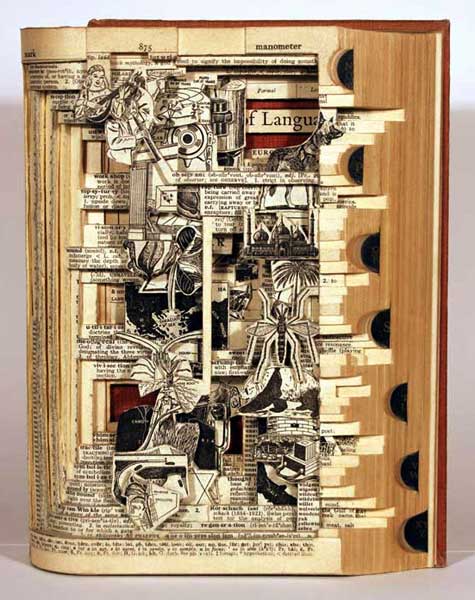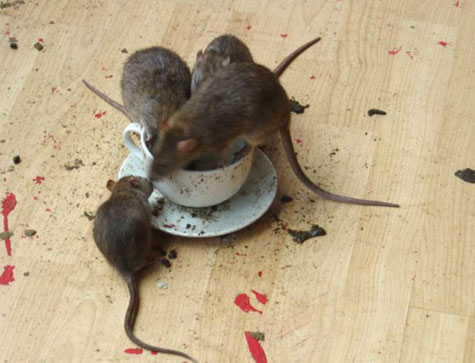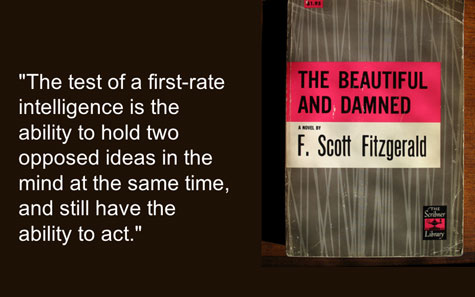Brian Dettmer’s Book Autopsies featured on the Centripetal Notion blog is well worth a look if you haven’t seen it already.

Found via Carole Garmon’s UMW Blogs post for her Video Art class here. Go UMW Blogs go!
Brian Dettmer’s Book Autopsies featured on the Centripetal Notion blog is well worth a look if you haven’t seen it already.

Found via Carole Garmon’s UMW Blogs post for her Video Art class here. Go UMW Blogs go!
 Lee Rosenbaum’s article in today’s Wall Street Journal adds another layer to the post I wrote about Randolph College selling off its art collection (inspired by Rosenbaum’s original post here). According to the article, one of the major forces behind struggling institutions auctioning off prized artwork could have something to do with the current market for American masterpieces. Especially given the fact that Alice Walton (heiress to the Wal-Mart fortune valued at $16.1 billion) is in search of art by US masters to fill her Crystal Bridges Museum of American Art in Bentonville, Arkansas which will be opening in 2009.
Lee Rosenbaum’s article in today’s Wall Street Journal adds another layer to the post I wrote about Randolph College selling off its art collection (inspired by Rosenbaum’s original post here). According to the article, one of the major forces behind struggling institutions auctioning off prized artwork could have something to do with the current market for American masterpieces. Especially given the fact that Alice Walton (heiress to the Wal-Mart fortune valued at $16.1 billion) is in search of art by US masters to fill her Crystal Bridges Museum of American Art in Bentonville, Arkansas which will be opening in 2009.
Looks like we have the makings of a modern day William Randolph Hearst, parvenus with an eye for breaking into the elite world of high-priced art and culture. And wouldn’t you know it, with $16 billion at your disposal it probably won’t be all that difficult. At the same time, the way in which this nation’s cultural heritage is valued and sold like prime real estate on the open market, should we really be surprised that individuals with so much money can and will purchase these works to build their own individualized empires of culture. Commodifying culture is nothing new, but has it reached the point of complete dislocation from the world we live in. Amy Branham, in her recent post “America Went Shopping While our Constitution Slowly Burned…”, does a nice job of tracing American’s reaction to their government’s flagrant abuse of personal freedoms in a post-9/11 political landscape:
Right after the horrific tragedy of 9/11, Americans were glued to their television sets. We couldn’t believe we had been attacked on our own soil and we were outraged. We mourned and we cried. We learned that it was terrorists who attacked us, specifically, al Qaeda. Shortly thereafter, the President declared war on al Qaeda.
Good American citizens across the country wanted to know what they could do to help. Go shopping, the President told us. Travel, and do the things you have always done. Don’t change your lives. Don’t let the terrorists win.
So, we went shopping in droves. We bought up gas guzzling SUV’s and RV’s, went to Wal-Mart en masse to buy up cheap goods from China, and we traveled the country. We continued to take our kids to soccer and baseball practice, went to movies and football games and did what we in America do best. We spent money. We bought homes and got mortgages we couldn’t really afford and the housing industry went through the roof.
We went to Wal-Mart en masse and bought cheap so that Alice Walton could bid high on our culture, all the while disregarding (or blatantly ignoring) what “Needs to Be Said” again and again and again.
And who said the Democratic congress would correct so many of the threats to our civil liberties? Isn’t it time for some real representation that doesn’t fall into the increasingly conservative alternative of the Democratic party? I hate to blog about politics in the US because it makes me so vitriolic, but how can I both dream and complain if I further an inexcusable silence?
You may have already heard that the Board of Trustees of Randolph College (a small, private women’s liberal arts college in Lynchburg, Virginia) made the controversial decision to sell off parts of its celebrated art collection to stay financially viable. The story has already been covered by the NYT, The Washington Post, and even the Chronicle took some time off from EdTech bashing to cover the news.
Nonetheless, I didn’t hear about this fascinating story from any of the above mass media outlets. Rather, I got the news from UMW Blogs. About three weeks ago I was reading the comments of Marjorie Och’s Art History students when one of them linked to this earlier article in the Washington Post about Randolph College considering selling a few of the college’s prized possessions to keep itself financially afloat. This article was particularly powerful because it briefly traced the intimate relationship between the artwork in the Maier Museum of Art at Randolph College and the school’s identity. The article frames how the school purchased its most valuable work, which will be auctioned at Christie’s in NYC next month, George Bellows’s “Men of the Docks:”

In the spring and summer of 1920, students at Randolph-Macon Woman’s College came up with a heady plan for the small school in a postage-stamp corner of the nation. They would pool their nickels, dimes, quarters and dollars to enhance the school’s fledgling art collection by obtaining a masterpiece: George Bellows’s “Men of the Docks.”
Under the direction of art professor Louise Jordan Smith, students put together $200. The college came up with $495. Townspeople and alumnae scraped up $1,500. As the students closed in on the purchase price of $2,500, the student paper jauntily reported: “Yesterday, one friend of the college donated $24 and another $50. Of course, the plan will come to a glorious end. Randolph-Macon undertakings always do. Who would like to donate the next $100?”
Talk about your glorious endings: “Men of the Docks” became the cornerstone of the school’s $100 million collection of American art, including works by Edward Hopper, Georgia O’Keeffe and William Merritt Chase.
I just love the way this is framed, everyday people pooling their pennies to buy a masterpiece born of school spirit and good will. A work which will be sold next month to the highest bidder for millions of dollars. All the while, Randolph College loses a piece of its institutional identity, further compounding the equally controversial decision to make this renowned women’s college co-educational as of this past August. It just seems so much like an epic tale of the virtues of collective identity and memory versus the voracious appetite of institutional myopia and mismanagement! Not to mention the larger questions of whether or not the board had the right to make such a decision. In fact, just recently Fisk University was refused the right to sell a Georgia O’Keefe masterpiece to a museum in order to jump start their emergence from financial hardship (NPR report here).
I also learned from my very brief research that the Maier Museum at Randolph College was designed during the cold war 50s as a fall-out shelter for The National Gallery of Art’s collection in Washington D.C. in the event of a nuclear attack. So fascinating to me!
Even more so when I once again stumbled upon a post on UMW blogs about the “Monday Massacre at Randolph College” by Marjorie Och, which provided a link to Culturegrrl’s blog post that features an interview with the now Ex-director of the Maier Museum (Karol Lawson) discussing the Elia Gonzalez-like raid on the museum last Monday, October 1st. In a late-afternoon, early-evening “raid,” the president of Randolph College seems to have organized a pick-up of four works of art (including the cherished Bellows piece, for transport to NYC for auction). The event seemed extremely mis-handled according to CultureGrrl’s report, and the police requested to “protect the artwork” cleared the area by tell onlookers there was a bomb threat (I love the irony CultureGrrl captures here, the cold war bomb shelter the site of a bomb threat!). The police department has since apologized for their actions, which were reprehensible.
Long story short, the school has, at least for the moment, lost the cornerstone of its art collection, lost three valued employees over the incident (including museum director Karol Lawson), along with a strongly worded condemnation from the Association of Art Museum Directors (well worth a read), and that feel-good story portending signs of hope and promise (however hidden) I read three weeks ago tentatively ends as most things do in this day and age –with little struggle, even less national outrage, and a whole lot of unaccounted for rage that is keeping close track of the number of times the American people have dociley taken it on the chin again and again by institutions, agencies, corporations, and organizations. All of which feel that they can do whatever they want in the name of “freedom, safety, and fiscal responsibility!” I hope the good folks of the Randolph College alumni associations and community groups head on up to NYC and grab that painting off the auction block, much like the administration stole away with it last Monday.
But, maybe this is just my own easily manipulated heart strings pushing me to righteously clamor for “what’s right!” Here is the administration’s press release explaining their position on selling the artwork -sounds like a million other poorly disguised excuses to make some quick cash. Sell outs! (I tried to be neutral there for a second, you saw me!)
If you ever had any question just how awesome Salvador Dalì was, then this clip from the 1950s game show “What’s My Line?” should quell any lingering doubts.
Found on Jack Turner’s Thought Bucket.
Looks like Brian Lamb, Alan Levine, and D’Arcy Norman are going back to school. Do EdTech slideshows get any cooler than this? Rhetorical question mind you, because they don’t!
Another gem from Check out My Fumanchu. Here are the details:
Part of the Grindhouse series revived by Quinten Tarentino and Robert Rodrigez, there were a lot of false trailers. One I stumbled upon was a fake trailer created by the director Rob Zombie, Werewolf Women of the S.S.. Part of the cast included Nicholas Cage whom… well just check out the trailer. I feel this may be a different medium that as well could be part of the more Hollywood manufactured video art.
Reminds me of the days at CBGBs seeing the ever-intolerant NYC Hardcore band S.O.D. (particularly when they quoted the 1974 Nazi-exploitation film Ilsa, She-wolf of the SS) while warming up for the Cro-Mags.
In 2004 DJ Danger Mouse’s re-mixed Jay-Z’s The Black Album and The Beatle’s The White Album to create The Grey Album. Looks like we now have The Grey Video which furthers this mash-up by mixing up A Hard Day’s Night and footage of Jay-Z performing.
Hip-hop is the mash-up, and the mash-up is hip-hop.
Originally found though Open Culture.
…I’m still just a rat in a cage.
To play upon a reading.
[kml_flashembed movie="http://www.youtube.com/v/1bjtV24MDzk" width="425" height="350" wmode="transparent" /]
How do you like your beady-eyed devils now, Mr Death!
As Scott, Brian, D’Arcy and I headed out of Logan on Friday afternoon we were bantering in the soccer mom minivan when D’Arcy, in his usual wry way, said, “Does anyone else have a rat problem?” We all busted out laughing simultaneously, and it was at that moment that the genius of Brian Lamb’s keynote at the 2007 Open Ed conference shot me like an invisible bullet.
“Does anyone else have a rat problem?”…brilliant! This statement came about mid-way in Brian’s keynote presentation and it is appropriate that I start a post about this epic presentation in medias res. Why the hell was he talking about his “rat problem” during a keynote about open education? Well, it certainly has much to do with impeccable timing and showmanship (not to mention balls of steel) and Brian himself would be the first one to shrug it off as his “song and dance.” However, anyone who was there (and/or anyone who has ever seen a compelling performance) knows that what made this moment so amazing was that it was the means through which Brian disarmed his audience by asking them a question that I now see worked on a number of different levels. The literal “rat problem” which immediately has everyone thinking to themselves “Nope, not me” (vermin in your life, how disgusting embarrassing, etc.).

But, at least for me, the figure of the rat is something far greater in this presentation–he spent four slides on rats and garbage–and I started thinking about why this crazy interlude to talk about his on-going spam problems with the UBC wiki, the current garbage strike in Vancouver, the 2010 Winter Olympics, as well as the rat problem in his garage that is born of this aforementioned strike which reflects on the political collusion that fuels an Olympics. A tirade which calmly transitions into a slide that takes us away from the uncomfortable digression about literal, metaphoric, and political rodents and returns us to questions about institutions letting go of managing expensive, proprietary, and outdated technology. The move between these conceits represents the rabid, unacknowledged population of possibility, like the hated rats, who live within the interstices of larger, complex systems as adept scavengers who not only survive, but prosper and multiply as a result of other people’s wasteful practices. Scavengers of the web who take resources from a wide range of services and cobble and steward them into the most powerful, affordable, and open learning resource known to man or vermin: the internets.
There’s no question I might be spinning this rodent thing far from Brian’s original intentions (sue me!), but it was the slide below (which followed the previous four about Vancouver vermin) that started me thinking about all of this…

What do small rats loosely joined think about the ordering of ideas here? Is it just a coincidence? I tend to think not, for every detail of this presentation was so precisely crafted, despite what Brian might have you think. Does it make any sense for a community of rats to try and survive and propagate within a system that actively tries to poison them? How do we explain their unbelievable resilience? Do we have a lot to learn from rats? Can we let go of our disgust for the rabble and vermin that constitute some part of any complex network, and exist within a logic that can balance these seemingly antithetical and incommensurate realities? The figure of the rat as Brian framed it in this presentation is at the heart of these questions for he is subtly re-valuing vermin and re-framing for us the reality we all live in, yet pretend not to be a part of. A sharp political statement as much as an outright challenge to consider the ways in which we sanitize the spaces in which the messiest of work must be done: teaching and learning.
As you can tell by now I have gone far afield from Brian’s presentation and given you just an impressionistic sense and hair-brained interpretation of the mad genius that weaved an unbelievable story around the ways that things coming part might not necessarily be understood in terms of loss. The ability for Brian to simultaneously challenge and embrace ideas may be facilely discounted as contradictory or incongruous. But, in fact, it is this faculty that made this talk so deeply inspiring, it wasn’t only unbelievably gripping as performance, it was also deeply evocative as a means to elegantly problematize while affectionately living within some of the basic tenets supporting the infra-structural ideas of educational technology. Brian’s final slide sums it up even more eloquently…

I’m not sure I have done the keynote presentation nor Brian any justice in the ramblings above, but I do know for sure that I will never look at rats in the same way again, especially rats from Vancouver. Bravo!
Some scavenged refuse from the talk: